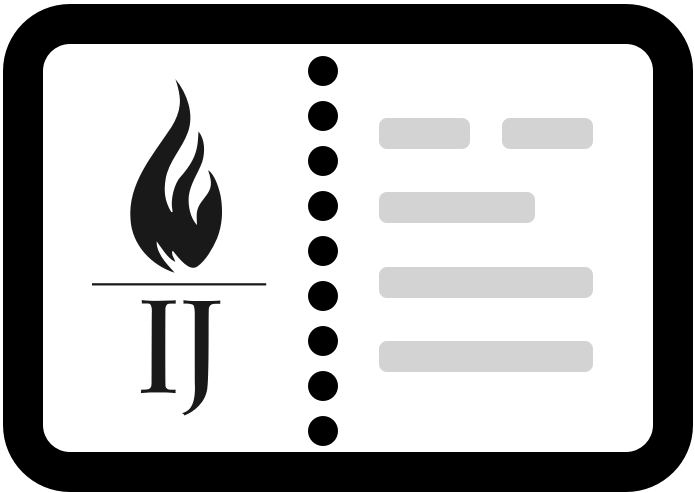Report: License to Work
Introduction to Occupational Licensing
Hanging by a Thread: Lata Jagtiani, an eyebrow threader in Louisiana, is fighting for her right to earn an honest living.
Ordinarily, landing a job means filling out an application, submitting a resume and interviewing with a prospective employer who will determine your fitness for the position. Or, if you want to be your own boss, it means setting up shop and convincing potential customers that your services are worth paying for.
But for a growing segment of Americans, gainful employment requires convincing someone other than a prospective employer or potential customer of their value. It requires convincing the government.
An “occupational license” is just that—government permission to work in a particular field. To earn the license, the aspiring worker must clear various hurdles: earn a certain amount or type of education, complete specialized training, pass an exam, attain a certain grade level, pay fees and more.
In the 1950s, only one in 20 U.S. workers needed the government’s permission to pursue their chosen occupation, according to occupational licensure expert and University of Minnesota professor Morris Kleiner. Today, that figure stands at almost one in three.1 The growing list of licensed occupations includes many often filled by those of modest means, such as cosmetologists, auctioneers, locksmiths, interior designers and African-style hairbraiders. Occupations like these can be ideal entry points into the job market.
Research to date—on occupations as diverse as school teachers, interior designers, mortgage brokers, dentists, physicians and others—provides little evidence that government licenses protect public health and safety or improve the quality of products or services.2 Instead, a greater body of work indicates that occupational licenses increase consumer costs3 and reduce opportunities for workers,4 particularly minorities, those with less education and older workers who may want to switch careers.5
This study is the first to document how widely low- and moderate-income occupations are regulated through licensure, as well as the first to measure how burdensome licensure laws are for aspiring workers. It does so by cataloguing the specific requirements needed to obtain a license for 102 lower-income occupations in all 50 states and the District of Columbia and then comparing the burdens those requirements represent across states and occupations.
Other Licensure Measures
Earlier measures of the scope of occupational licensing have focused on somewhat different questions. The Pacific Research Institute (PRI) collected licensure data for a small sample of occupations across all 50 states and combined that with other indicators to create its U.S. Economic Freedom Index.6 Fifteen of the occupations in the PRI index are non-health care related and cover a broad range of the socio-economic spectrum—barbers, architects and real estate agents, for example. Another 42 of the occupations come from the health care sector and range from physicians to drug counselors.
Similarly, the Freedom in the 50 States index published by the Mercatus Center includes among its indicators a measure of occupational licensure.7 This index counts how many of 800 occupations listed by the Bureau of Labor Statistics (BLS) are licensed across the states. The report found that 191 occupations are licensed in some but not all states, and 93 occupations are licensed in all states.
Finally, a Reason Foundation report counted the number of occupations in each state requiring a license to work.8 The report found that states require licenses for 92 occupations, on average. According to this report, California leads the nation, licensing 177 job categories, almost double the national average.
Burdens of Licensure for Lower-Income Workers
One key way this report differs from these earlier efforts is by focusing on low- and moderate-income occupations. The 102 occupations studied are those recognized by the BLS in which practitioners make less than the national average income and where the occupation is licensed in at least one state. These occupations are often well-suited for individuals just entering or re-entering the economy. The list also includes occupations ideal for new small business creation. Thus, this report documents the impact of occupational licensing on those on the first several rungs of the economic ladder.
Another distinguishing feature of this report is its measurement of not just whether an occupation is licensed but how difficult the license is to obtain. The report captures the five types of requirements most commonly imposed on applicants for licensure: fees, education and training, exams, minimum age and minimum grade completed. These data enable us to compare how difficult the 50 states and D.C. make it for aspiring workers to enter various occupations.
Such licensure hurdles are likely exceptionally burdensome for lower-income workers, particularly compared to higher-paid occupations like physicians, attorneys and the like. Not only do those entering or re-entering the work world typically have fewer resources than those pursuing high-income occupations, but if they clear these hurdles, they will face an income stream often markedly less than the national average.
Like earlier research, our study finds that occupational licensing is widespread. More than that, it finds that the burdens imposed on job-seekers and would-be entrepreneurs are often severe, arbitrary and irrational.
Tip of the Iceberg
Still, this report understates the extent to which government regulations keep people out of work. For starters, it misses certain occupational licenses, including those issued by cities, counties or the federal government, as well as licenses for occupations not covered by the BLS. The BLS counts some trades as subsets of others, skips some occupations that are too small to gather data on and tends to exclude newer, innovative occupations until they are more established; such occupations are likewise absent from our study. By focusing on licensing, it also misses other obstacles to employment, such as red tape, zoning regulations and other kinds of licenses documented in the Institute for Justice’s “city study” series of reports on barriers to entrepreneurship in various cities.9
Throughout this report, sidebars explore some of the licenses and other barriers to work not captured by our main analysis. They show that our findings are truly the tip of the iceberg.
The report also understates the impact of licensing by taking a conservative approach to documenting license requirements. When states offer multiple levels of licensure, we included the easiest-to-obtain level that allowed for the broadest scope of work. Those wishing to advance in such a field would need to meet additional requirements.10
1 Kleiner, M. M., & Krueger, A. B. (2010). The prevalence and effects of occupational licensing. British Journal of Industrial Relations, 48(4), 676–687.
2 Angrist, J. D., & Guryan, J. (2008). Does teacher testing raise teacher quality? Evidence from state certification requirements. Economics of Education Review, 27, 483–503; Buddin, R., & Zamarro, G. (2008). Teacher qualifications and student achievement in urban elementary schools. Journal of Urban Economics, 66, 103–115; Carpenter, D. M. (2008). Regulation through titling laws: A case study of occupational regulation. Regulation and Governance, 2(3), 340-359; Carroll, S. L., & Gaston, R. J. (1981). Occupational restrictions and the quality of service received: Some evidence. Southern Economic Journal, 47(4), 959-976; Kleiner, M. M., & Kudrle, R. T. (2000). Does regulation affect economic outcomes: The case of dentistry. Journal of Law and Economics, 43(2), 547-582; Kleiner, M. M., & Petree, D. L. (1988). Unionizing and licensing of public school teachers: Impact on wages and educational output. In R. B. Freeman & C. Ichniowski (Eds.), When public sector workers unionize (pp. 305-319). Chicago: University of Chicago Press; Kleiner, M. M., & Todd, R. M. (2007). Mortgage broker regulations that matter: Analyzing earnings, employment, and outcomes for consumers. Cambridge, MA: National Bureau of Economic Research; Paul, C. (1984). Physician licensure legislation and the quality of medical care. Atlantic Economic Journal, 12(4), 18-30; Skarbek, D. (2008). Occupational licensing and asymmetric information: Post-hurricane evidence from Florida. Cato Journal, 28(1), 73-82.
3 Chevalier, J. A., & Morton, F. M. S. (2008). State casket sales restrictions: A pointless undertaking? Journal of Law and Economics, 51, 1-23; Harrington, D. E., & Krynski, K. J. (2002). The effect of state funeral regulations on cremation rates: Testing for demand inducement in funeral markets. Journal of Law & Economics, 45, 199-223; Kleiner and Kudrle, 2000.
4 Adams, A. F., Jackson, J. D., & Ekelund, R. B. (2002). Occupational licensing of a credence good: The regulation of midwifery. Southern Economic Journal, 69(3), 659-675; Carpenter, C. G., & Stephenson, E. F. (2006). The 150-hour rule as a barrier to entering public accountancy. Journal of Labor Research, 27(1), 115-126; Federman, M. N., Harrington, D. E., & Krynski, K. J. (2006). The impact of state licensing regulations on low-skilled immigrants: The case of Vietnamese manicurists. American Economic Review, 96(2), 237-241; Jackson, R. E. (2006). Post-graduate educational requirements and entry into the CPA profession. Journal of Labor Research, 27(1), 101-114; Jacob, J., & Murray, D. (2006). Supply-side effects of the 150-hour educational requirement to CPA licensure. Journal of Regulatory Economics, 30(2), 159-178; Kleiner and Todd, 2007.
5 Angrist and Guryan, 2008; Dorsey, S. (1983). Occupational licensing and minorities. Law and Human Behavior, 7(2-3), 171-181; Federman, et al., 2006; Harrington, D. E., & Treber, J. (2009). Designed to exclude. Arlington, VA: Institute for Justice; Kleiner, M. M., & Krueger, A. B. (2008). The prevalence and effects of occupational licensing. Cambridge, MA: National Bureau of Economic Research.
6 McQuillan, L. J., Maloney, M. T., Daniels, E., & Eastwood, B. M. (2008). U.S. economic freedom index: 2008 report. San Francisco: Pacific Research Institute.
7 Ruger, W. P., & Sorens, J. (2009). Freedom in the 50 states: An index of personal and economic freedom. Arlington, VA: Mercatus Center.
8 Summers, A. (2007). Occupational licensing: Ranking the states and exploring alternatives. Los Angeles: Reason Foundation.
9 See, for example, Berliner, D. (1997a). How Detroit drives out Motor City entrepreneurs. Arlington, VA: Institute for Justice; Berliner, D. (1997b). Running Boston’s bureaucratic marathon. Arlington, VA: Institute for Justice; Bindas, M. (2010). L.A. vs. small business: City of angels no heaven for entrepreneurs. Arlington, VA: Institute for Justice; Dranias, N. (2006). The land of 10,000 lakes drowns entrepreneurs in regulations. Minneapolis, MN: Institute for Justice; Hottot, W. (2010). Houston, we have a problem: Space city regulations prevent entrepreneurs from taking off. Arlington, VA: Instititue for Justice; Sherman, P. (2010). Miami’s vice: Overregulating entrepreneurs. Arlington, VA: Institute for Justice. For more studies like these, visit: http://www.ij.org/citystudies.
10 In addition, depending on the nature of the work and the setting in which it is performed, some occupations may be subject to additional or alternative licensing regimes not captured here. For example, the licensing requirements reported for social and human service assistants are those of social work assistants and social work associates. Some workers in this field, however, may need a psychology associate license or a similar license in another related field.



